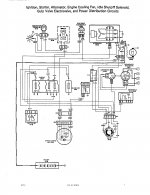I am the happy owner of a Fiat 124 spider from 1979
After replacing a worn out alternator I have problems with power for the ignition
When I turn the key there are no problems with the starter and the headlights, but no power for the ignition.
Since there is no power for the interior light, oil pressure lamp, clock, seatbelt alarm and signal I would expect a broken fuse, but the fuse is ok.
The problem is not permanent sometimes I’m lucky and the ignition and everything works.
Can anybody help me with this problem?
Is it old relais?
I thank you in advance !
After replacing a worn out alternator I have problems with power for the ignition
When I turn the key there are no problems with the starter and the headlights, but no power for the ignition.
Since there is no power for the interior light, oil pressure lamp, clock, seatbelt alarm and signal I would expect a broken fuse, but the fuse is ok.
The problem is not permanent sometimes I’m lucky and the ignition and everything works.
Can anybody help me with this problem?
Is it old relais?
I thank you in advance !
Last edited:


